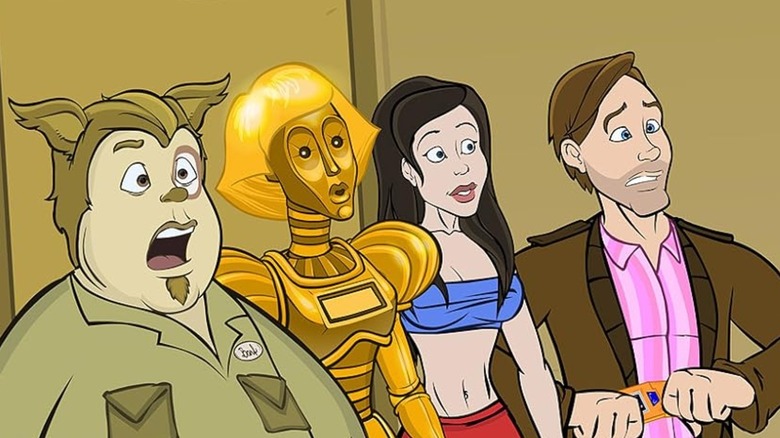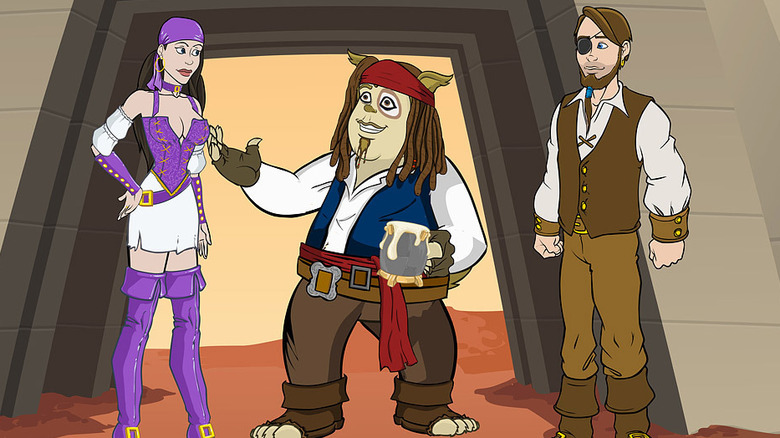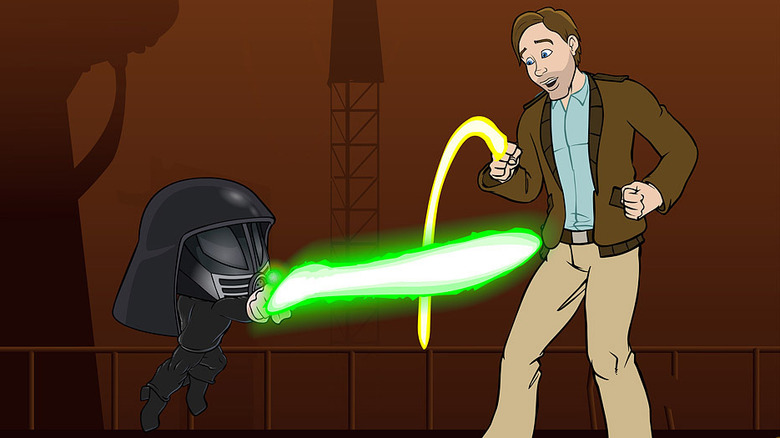The Spaceballs Spin-Off Series That You Didn't Know Existed
Amazon and MGM have revealed that a "Spaceballs" sequel is officially moving forward, with Mel Brooks — on the cusp of his 99th birthday — returning to reprise his role as Yogurt from his original 1987 spoof movie. This news fulfills a lot of eager anticipation, as "Spaceballs" fans (many of whom have sore backs) have been speculating as to whether or not it would happen for years. The film's teaser trailer hilariously points out that since 1987, there have been numerous "Star Wars" TV shows and movies, not to mention Disney animated films, remakes of those movies, and prequels to those remakes. There were also, as the teaser notes, many "Alien" and "Predator" films, several "Jurassic Park" movies, eight "Harry Potter" films, a developing TV show remake of those movies, and 36 films set in the Marvel Cinematic Universe. But, it adds, there was only one "Spaceballs."
That, however, isn't entirely accurate. Technically, since 1987, there have been two "Spaceballs." It's just that one dangles down a lot further than the other. Few remember the short-lived, and perhaps ill-advised, "Spaceballs: The Animated Series," which ran for 13 episodes back in 2008 and 2009. It aired on G4, the digital network that became best known for its reportage on the mid-2000s video game industry.
"Spaceballs: The Animated Series" reunited original cast members Daphne Zuniga, Joan Rivers, and Dom DeLuise, who played Princess Vespa, Dot Matrix, and Pizza the Hutt, respectively, while Brooks returned to voice both Yogurt and President Skroob. Bill Pullman (who played Lone Starr) was replaced by Rino Romano, John Candy (who played Barf before passing away in 1994) was replaced by Tino Insana, George Wyner (who played Colonel Sandurz) was replaced by David Wittenberg, and Rick Moranis (who had been retired for years at that point) was replaced by Dee Bradley Baker. Julianne Groassman also took over the role of Commanderette Zircon from Leslie Bevis but played most of the show's supporting female characters as well.
The show is ... okay.
Spaceballs: The Animated Series was merely okay
The "Spaceballs" cartoon does try to capture some of Brooks' propensity for puns, low-art humor, and borscht-belt style comedy, but most of this falls flat in animation. Brooks could write cheap puns into his movies because a talented comedic actor could deliver them with a wink to the camera. In animation, especially when employing the unexpressive style used in "Spaceballs: The Animated Series," the gags are merely bad. It's a series that tries to elicit titters from a line like "We must throw the One Onion Ring into the deep fryers of Lardor." A live comedian or perhaps MAD Magazine could make that funny. "Spaceballs: The Animated Series" does not.
On top of that, the show uses Flash animation, so its characters move more like paper dolls than fully articulated figures. Everything looks stiff and cheap.
Meanwhile, the show's plotlines are broad and silly, but that's in-keeping for its comedy. "Spaceballs: The Animated Series" also hews closer in execution to "Family Guy" than to the "Spaceballs" movie, eager to spoof all of popular culture and not just "Star Wars" (with a few jokes aimed at franchises like "Alien" tossed into the mix). Rather, the "Spaceballs" cartoon skewers both current events and pop culture from its era, incorporating parodies of "Pirates of the Caribbean," "Grand Theft Auto," and "Lord of the Rings" (as alluded to above) while simultaneously nodding to incidents like the E. coli outbreak. The show is at its strongest when it sticks to satirizing "Star Wars." For example, it starts by spoofing George Lucas' prequel trilogy, revealing that Dark Helmet was originally a boy named Pannakin Crybaby.
(Dark Helmet, by the way, is animated to look two feet tall, which is an odd aesthetic choice. Rick Moranis is 5' 6"; he's not that short.)
The Spaceballs cartoon wasn't well-received by either fans or critics
The one piece of "Spaceballs" canon that "The Animated Series" did explicitly re-write was Lone Starr's royal lineage. It was revealed at the end of Brooks' 1987 film that Lone Starr was secretly a prince his whole life, which allowed him to marry Princess Vespa. In "Spaceballs: The Animated Series," however, it's revealed his royal lineage was a misreading of a birth certificate, which results in his marriage to the princess being annulled.
The "Spaceballs" cartoon wasn't well-received by fans either, partly due to a mysterious production delay. The show was announced at the 2007 San Diego Comic-Con, with the plan being that G4 would make 13 episodes, the first of which would premiere at an unknown date. In the end, though, the show wouldn't see the light of day until September 21, 2008, 16 months after its was first announced. By then, enthusiasm had kind of died down, and many people had stopped paying attention.
Unfortunately, the series wasn't terribly well-reviewed either. IGN gave the show a 4 out of 10, stating the parodies were glib and obvious and the humor wasn't funny. Wired, likewise, felt the "Spaceballs" cartoon was simply lacking when it came to its comedy, noting that spoofery of that type had already been ruined by the then-recent wave of terrible, reference-heavy spoof films that had infected theaters throughout the mid-2000s. Indeed, "Date Movie," "Superhero Movie," and IMDb's sworn enemy, "Disaster Movie," all came out at around the same time as "Spaceballs: The Animated Series," stealing the show's thunder and reflecting poorly on its satire.
If the crew behind the "Spaceballs" sequel are savvy, the film will reference the original movie's animated spin-off. Assuming Brooks has any say in the matter, he would probably mention it merely to dismiss it, and the fourth-wall-breaking nature of the movie will allow a character to note that "animated shows don't count." We'll have to wait and see if the Schwartz awakens when the film hits theaters in 2027.


